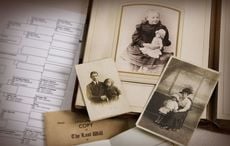Dan Dowd from Dingle was my great-great-granduncle. Dan Dowd was also my father’s name, it is my brother's name though he now uses Donal O’Dowd and it's my nephew's name also Donal O’Dowd. My older brother Fergus had done some deep research and the connection with the great Paddy Bawn Brosnan (famed Kerry footballer) came up as did some terrible truths about how poor Dan eventually dies in the Confederate hell hole known as Andersonville.
What follows is Damien Shiels’ research and story of my great great granduncle . It made me incredibly proud to read his story of fighting for his adopted country---Nialll O'Dowd.
Kerry emigrant Dan Dowd's American Civil War
By Damian Shiels
Last July I gave a talk to Dingle Historical Society in Co. Kerry, and was fortunate to be contacted by local man Mossy Donegan. Mossy not only knew his own connections to the conflict, but through extensive research by both he and his sister Maeve had obtained copies of many of the historical files associated with those links. It is a familial story they share with Paddy Bawn Brosnan, and it is as a result of Mossy and Maeve’s endeavours that it can be related here.
Father Eugene O’Sullivan married Daniel and Mary in Dingle Roman Catholic Church on 29th October 1853, A year later, on 8th October 1854, they celebrated the birth of their first child, Edward. At some point shortly after that, the Dowds decided their future lay across the Atlantic, and became just three of the more than 54,000 people who emigrated from Kerry between 1851 and 1860.
The favored destination for Irish emigrants was New York, and that is where the young Dowd family arrived in the mid-1850s. A second child– a daughter Bridget– was born there about 1856. Bridget, or Biddy as she became known, came into the world on Long Island, and was Paddy Bawn Brosnan’s grandmother. If the Dowd family story had followed that of the majority of Irish immigrants to the United States in this period, Biddy Dowd would never have seen Ireland again, and Paddy Bawn Brosnan would never have been born. But seismic events intervened. By the 1860s the family had settled in Buffalo, where Daniel made the decision that changed all their lives forever, when on 6th September 1862 he enlisted in the Union army.
In 1862 Daniel Dowd became one of the c. 200,000 Irish-born men who would serve during the American Civil War. He was joined in the ranks by thousands of Kerrymen; there is little doubt that it was this conflict that saw more Kerrymen fight, and more Kerrymen die, than any other war in history. The Dingle native had decided not to join just any unit. Instead he enlisted in the 155th New York Infantry, one of the regiments that would form part of Corcoran’s Irish Legion. Its leader Brigadier-General Michael Corcoran from Carrowkeel, Co. Sligo was a noted Fenian, and many supporters of the cause of Ireland specifically chose to join his brigade. Whether Daniel was one of them, or simply wanted to serve close to his fellow Irishmen, remains unknown.
Daniel was mustered in as a private in Company I of the 155th New York at Newport News, Virginia on 19th November 1862. He was recorded as a 29 year old laborer who was 5 feet 5 inches in height, with a fair complexion, gray eyes and light hair. His surname was one that caused considerable confusion for recorders at the time. Sometimes recorded as Doud or Doody, Daniel was placed on the regimental roster as ‘Daniel Dout.’ It wasn’t long before he got his first taste of action in the Civil War, as in January his regiment was engaged the Battle of Deserted House, Virginia. Though only a mere skirmish in comparison to what the Legion would endure in 1864, it nonetheless must have had quite an impact on Daniel and the men of the 155th.
Private Daniel Dowd spent the next year in Virginia with his unit. On 17th December 1863 he found himself guarding a railroad bridge, part of a detachment of some 50 men of the Legion that were protecting the Orange & Alexandria line at Sangster’s Station. At a little after 6pm that evening they were set upon by a body of Confederate cavalry, who threatened to overrun them as they sought to burn the bridge.
The Rebels attacked on a number of occasions, eventually getting around the flanks and rear of the Irishmen, succeeding in setting fire to their tents and forcing them into a retreat. Cut off, the detachment would normally have looked to their telegraph operator to call for reinforcements, but he was apparently so drunk he was unable to use his equipment. General Corcoran and the remainder of the Legion only learned of the attack around 8.30pm, when a local Unionist came to inform them of events. The relief force eventually re-established a connection with the detachment, but although the bridge was saved, a number of men had been captured. Among them was Dingle-native Daniel Dowd.
We have scant details of Daniel’s life as a prisoner-of-war, but initially he was likely held near Richmond. At some point in the spring or early summer of 1864 he was moved to the recently opened– and soon to be notorious– Camp Sumter, Georgia. Better known as Andersonville, between February 1864 and the close of the war almost 13,000 prisoners lost their lives in the unsheltered compound. Disease, much of it caused by malnutrition, was rife. On 3rd July 1864 Daniel was admitted to the camp hospital suffering from Chronic Diarrhea. He must have been in an extremely severe state at the time, as he did not live through the day. Following the conflict his grave was identified, and today forms part of Andersonville National Cemetery, where he rests in Grave 2809.
Shorn of her main support, the now widowed Mary decided to leave America behind and retrace her steps to Dingle, presumably to be close to family who could provide assistance. She returned to her hometown with Edward and Biddy in tow; Edward must have had little or no-memory of Kerry, while Biddy was experiencing Ireland for the very first time. In 1869 Mary, now 45-years-old, went in search of a U.S. widow’s pension based on Daniel’s service to help support the children. Now living on the Strand, Dingle, she compiled information about her marriage and her children’s birth to send to Washington D.C. as part of her application. Unfortunately, the variant spellings of her husband’s name came back to haunt her. In the marriage record, Daniel’s surname had been written as ‘Doody’, sufficiently different from the ‘Dout’ recorded on the regimental roster to raise suspicions that this was not the same man. To compound matters there was also no available documentation relating to Biddy’s birth. Although the Commissioner of Emigration had written to every Catholic parish in Long Island in order to locate it, he met with no success. The combination of these two issues, together with the difficulty in dealing with the Washington authorities at such a remove, meant that Mary’s pension wasn’t granted. Her failure to provide the additional evidence requested meant that her claim was classified as ‘abandoned.’ Mary never fully gave up fully on the process; the last entry in her file is a letter she had written in the 1890s. Addressed from Waterside, Dingle on 4th July 1892, it was sent to the Secretary of the Claim Agent Office at the White House in Washington D.C.:
Sir,
I beg to state that I Mary Dowd now living here and aged about 65 am the widow of Daniel Dowd who served as a soldier in the late American war of 1863, and died a Prisoner of War in Richmond Prison Virginia [actually in Andersonville, Georgia]. Said Daniel Dowd served in the Army of the North. After his death, I deposited the necessary documents to prove my title to pension, in the hands of a Mr. Daniel McGillycuddy Solicitor Tralee, with the view to place them before the authorities in Washington , and he on 27th December 1873, forwarded the same to a Mr. Walsh a Claim Agent, for the purpose of lodging same. Since, I have not received a reply to my solicitor’s letters or received any pay nor pension or acknowledgement of claim.
I also learn that my husband at his death had in his possession £100, which he left to Father Mc Coiney who prepared him for death, in trust for me, and which sum never reached me.
I know no other course better, than apply to you, resting assured that you will cause my just claim to be sifted out, when justice will be measured to a poor Irish widow who is now working hard to maintain a long family.
Daniel and Mary’s American born daughter Biddy in later life in Dingle (Mossy Donegan)
As was common at the time, Mary was illiterate– the letter was written for her by her solicitor McGillycuddy, and she made her mark with an ‘X’. It seems unlikely she ever received any monies as a result of it. Her American-born daughter Biddy grew to adulthood in Ireland. Her home had become Dingle, Co. Kerry rather than Buffalo, New York entirely as a result of her father’s death in a Prisoner of War camp more than 6,000 km from Ireland. Daniel’s fateful Civil War service also meant his daughter married and started a family in Ireland rather than America. Biddy’s husband was a fisherman, Patrick Johnson, and together the couple had seven children. One of them, Ellie, was Paddy Bawn Brosnan’s mother. Biddy died in 1945 and is buried in St. James’s Church in Dingle. Unlike her father’s resting place in Andersonville, it is not marked with a headstone.The American Civil War had a long-lasting, inter-generational impact on tens of thousands of Irish people, both in Ireland and the United States. Had it not been for the Confederate decision to launch an attack at Sangster’s Station in Virginia in 1863, or Daniel’s incarceration in Georgia in 1864, it is unlikely that Paddy Bawn Brosnan would ever have been born. The story of the footballing legend’s family is evidence of the often unrecognized impact of what was the largest conflict in Kerry people’s history.




Comments